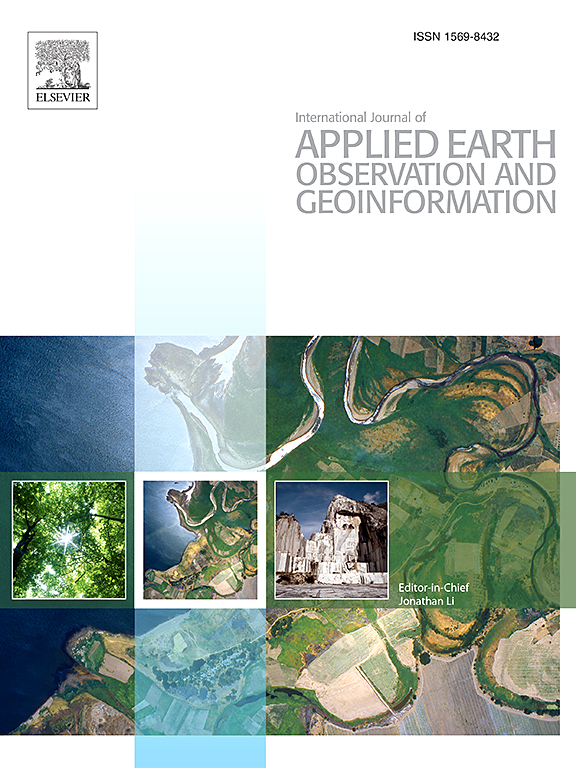A meta-review of remote sensing for rubber plantations
IF 8.6
Q1 REMOTE SENSING
International journal of applied earth observation and geoinformation : ITC journal
Pub Date : 2025-05-29
DOI:10.1016/j.jag.2025.104625
引用次数: 0
Abstract
The rapid expansion of rubber plantations has led to significant ecological impacts, including deforestation and reduced carbon storage capacity, such as rubber-induced 4.1 million ha of forest loss in Southeast Asia (SEA). Remote sensing, essential for monitoring rubber expansion and supporting initiatives like REDD+ and EU deforestation regulations. However, due to the heterogeneity, dynamism, and complexity of rubber plantations, developing universal mapping algorithms remains challenging, and there is a lack of all-around reviews on remote sensing research specific to rubber plantations. Our meta-review systematically analyzes 305 peer-reviewed papers (2000–2024), synthesizing advancements in remote sensing techniques. The findings show that research is primarily focused on SEA (82 %), while regions like Africa and South America are underexplored. Optical data remains dominant (68 %), but the use of SAR has tripled, achieving up to 89 % accuracy when combined with phenological features. Additionally, deep learning improved classification accuracy by 15–20 %, especially in detecting young plantations under six years old. However, discrepancies and gaps in global plantation maps persist due to inconsistent validation methods and resolution limitations (>30 m). Our review highlights the need for standardized global datasets and provides insights into future research directions, including improved feature selection, algorithm transferability, and better integration of multi-source data to support sustainable plantation management and accurate carbon accounting.
橡胶园遥感研究综述
橡胶种植园的迅速扩张导致了重大的生态影响,包括森林砍伐和碳储存能力的降低,例如橡胶导致东南亚410万公顷的森林损失。遥感对于监测橡胶扩张和支持REDD+和欧盟森林砍伐法规等倡议至关重要。然而,由于橡胶种植园的异质性、动态性和复杂性,开发通用的测绘算法仍然具有挑战性,并且缺乏针对橡胶种植园的全面的遥感研究综述。我们的元综述系统地分析了305篇同行评议的论文(2000-2024),综合了遥感技术的进步。研究结果表明,研究主要集中在东南亚(82%),而非洲和南美洲等地区的勘探不足。光学数据仍然占主导地位(68%),但SAR的使用增加了两倍,当结合物候特征时,准确率达到89%。此外,深度学习将分类准确率提高了15 - 20%,特别是在检测6岁以下的年轻种植园时。然而,由于不一致的验证方法和分辨率限制(>30 m),全球人工林地图中的差异和差距仍然存在。我们的综述强调了标准化全球数据集的必要性,并为未来的研究方向提供了见解,包括改进特征选择、算法可移植性和更好地整合多源数据,以支持可持续的人工林管理和准确的碳核算。
本文章由计算机程序翻译,如有差异,请以英文原文为准。
求助全文
约1分钟内获得全文
求助全文
来源期刊

International journal of applied earth observation and geoinformation : ITC journal
Global and Planetary Change, Management, Monitoring, Policy and Law, Earth-Surface Processes, Computers in Earth Sciences
CiteScore
12.00
自引率
0.00%
发文量
0
审稿时长
77 days
期刊介绍:
The International Journal of Applied Earth Observation and Geoinformation publishes original papers that utilize earth observation data for natural resource and environmental inventory and management. These data primarily originate from remote sensing platforms, including satellites and aircraft, supplemented by surface and subsurface measurements. Addressing natural resources such as forests, agricultural land, soils, and water, as well as environmental concerns like biodiversity, land degradation, and hazards, the journal explores conceptual and data-driven approaches. It covers geoinformation themes like capturing, databasing, visualization, interpretation, data quality, and spatial uncertainty.
 求助内容:
求助内容: 应助结果提醒方式:
应助结果提醒方式:


